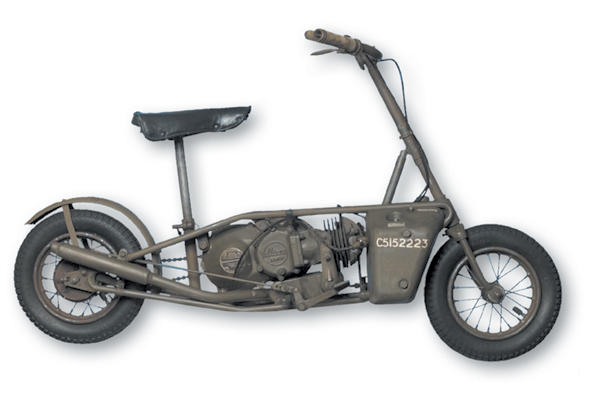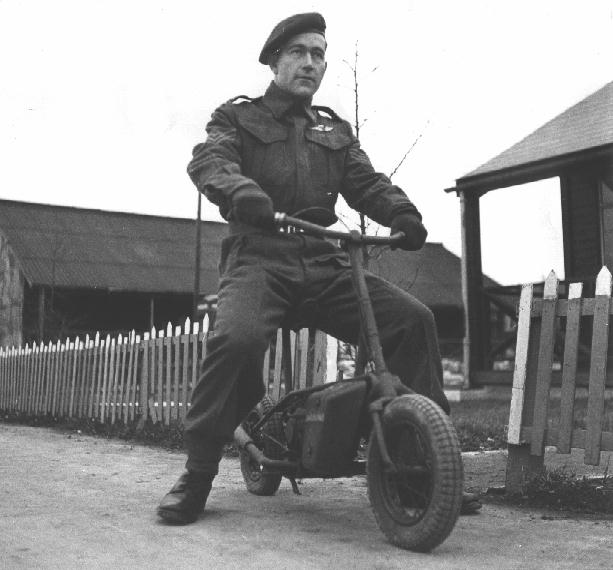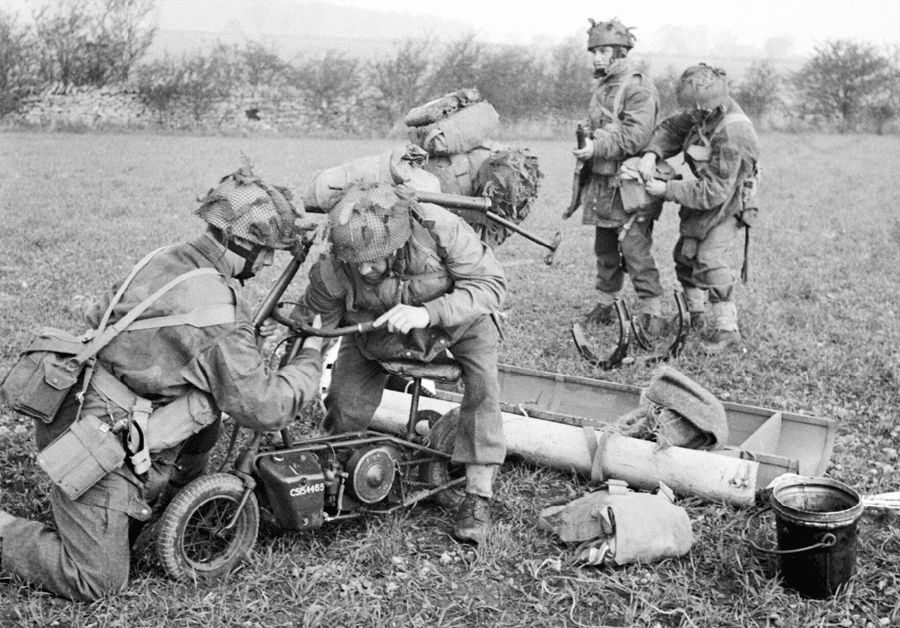Imagine being the first guy to jump out of an airplane with a prototype parachute connected to your back. Pretty crazy stuff, but in World War II, it was a cutting-edge way to invade a nation, take ground, and put troops right where you need them. Yet, when it comes to tossing troopers out of planes, you have to toss more than troopers. They need guns, gear, and supplies, so you have to toss those out of a plane too. They may also need transport, and that is why the British came up with the Welbike.
Specifically, this design was dreamed up by Station IX, a part of the British Special Operations Executive. Station IX dreamed up all sorts of crazy stuff, but the Welbike is by far their coolest invention. SOE employee and motorcycle enthusiast named Harry Lester designed the Welbike.
The Welbike is a folding motorcycle designed to parachute with the troopers to give them an on-demand form of transportation. It’s a fascinating piece of gear, and today we are going to dissect it and look at what made it so dang cool.
Into the Welbike

These days transporting gear, including vehicles, isn’t that hard. We have many ways to insert vehicles into warzones. That wasn’t the case in 1942.
The SOE designed the Welbike to fit into a CLE Canister. CLE stands for Central Landing Establishment, and later Container, Light Equipment. These containers were used to drop anything. You could fill them full of food, ammo, supplies, or anything else. The SOE needed to build a motorbike that could fit inside these containers which were five feet six inches long and 16 inches in diameter.
Those dimensions necessitated a small bike with an odd and interesting design. As a result, the Welbike was more akin to a scooter than a motorcycle. To fit into the canister, the designers eliminated the suspension and any lights and equipped the little fellow with a single rear brake.
Another consideration was the ultra-small gas tank. It held only 3.7 liters of fuel and was mounted below the carburetor. This meant that the tank had to be pressurized, and a hand pump was built into the Welbike. (The tank was meant to be pressurized prior to the jump to save time.)
Its engine was a small but efficient six cubic inch single-cylinder two-stroke gasoline engine produced by Villiers.
The Welbike could reach speeds of 30 miles per hour and, with a full tank, could traverse 90 miles. Not too bad for a little air-dropped scooter with a fully equipped trooper.
Related: Letters to Loretta: Life in German POW camp Stalag 17B
Readying the Welbike

After the troopers and motorcycles were in the air, they parachuted to the ground. Once they got to the ground, the paratrooper hunted down their motorcycle. The motorcycle rode with a green parachute, so it was easily identifiable. There was also an indication on the container carrying the motorcycle in case there was any confusion.
The paratrooper unloaded the bikee, twisted the handlebars into position, and locked them in place with spring-loaded pins. The seat was pulled upward, and the footrests folded outwards. All in all, a Welbike could be readied in 11 seconds reportedly.
Related: How WWII aviation inspired sights and sounds of ‘Star Wars’
In service

The Welbike saw extensive testing and was repeatedly dropped from planes.
The little scooter was cheap to produce and reliable. It entered full production with approximately 3,600 motorcycles produced for use in operations throughout the second World War.
While the bike found some service in use with the paratroopers, it also found success elsewhere. Royal Marines and commando units also used the little Welbike, including at Normandy and Anzio. Airborne units also used the Welbike at Arnhem and during Operation Market Garden.
Crews on RAF airbases also found the little bike to be quite handy. It was easy to use zipping around the airfields, and was likely a thrilling little ride.
Going 30 mph with a single rear brake would be a ton of fun. I explained that to my wife, and she said, “Well, they jumped out of planes, so it wasn’t the craziest thing they did that day.”
But it wasn’t all rainbows and wheelies and there were a few tactical issues at hand. The bike and canister weighed more than the men parachuting, causing them to fall away from the troopers.
Troopers then had to try and locate the bikes while dealing with enemy forces. That can be a big problem under fire. The vehicles were also a bit more hazardous when used over rough terrain and sometimes incapable of crossing certain terrain. This often caused them to be abandoned in the field.
The end of an era
The Welbike evolved into various models featuring a few different modifications which included mudguards and a simplified gas tank.
After the end of WWII, the Welbike and the concept of a trooper scooter was largely abandoned, besides some experiments by the British Navy. Yet, while the Welbike might not have changed the outcome of any battles, I’ve never seen a surplus vehicle I want more.
Feature Image: British paratroopers unfolding a Welbike. (Creative Commons)




